



Trans-gender theorist Jami Weinstein has compared the flocking behaviour of academics and artists around the concept of The Anthropocene, to the adoption by the Hipster of a given locale or fashion appendage. The creative flock, she suggests, can perform a gentrification of concept through uncritical adoption and ‘hyper-consumption’, just as it does of neighbourhoods or workwear. The Anthropocene is indeed the place to be seen, or the guise in which to dress the body of your work, this season. The term is proposed as a way of describing the explicit ‘age’ in which human kind, post-1945 (although possibly since the Industrial Revolution, or stretching right back to the advent of tool use), has come to define the geophysics of the entire earth.
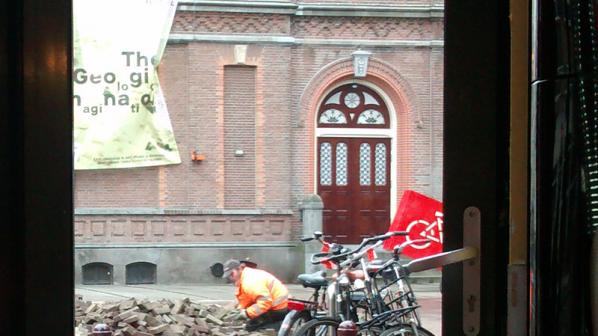
The Anthropocene, combining geology with sociology through a few slights of hand, therefore collapses the distinction of human and nature which is core to basic understandings of our being in the world. If this wasn’t enough, an immanent vote affirming the accuracy of the term The Anthropocene by the scientific community worldwide has also been touted as a gesture which will provide the rhetorical turning point by which the Western powers will acknowledge, and begin reparations for, the ecological sins of the past, potentially saving the human race from mass extinction. Fertile ground then, for readings, interpretations and responses – but as Weinstein suggests, there is a deeply complex responsibility implied when we approach and engage with something as ontologically vulnerable as a concept.
It is this responsibility Sonic Acts assumes when it takes The Anthropocene as its central theme. The four day music festival and conference takes a collection of essays titled The Geologic Imagination as a gathering point for a strong line-up of some of the most influential men working across philosophy, music and the arts today. I attended the first day of the festival, which included a talks and a round-table by Object Oriented Ontologists maverick Graham Harman and his icemanTim Morton, geologist Mark Williams, and art theorist Douglas Kahn, followed by a performance/installation by Florian Hecker featuring work by Reza Negarestani, and a night-time programme of music by M.E.S.H and TCF, Vessel, and finally, as if from outer space, the sole female agent of the programme, Karen Gwyer.
I use the term agent, to distinguish from ‘appearance’ or ‘voice’, because there were several female bodily appearances and women’s voices in evidence onstage during the conference and club. The problem was that they were routinely either denied the right to articulate their own words, for example when The Geologic Imagination editor Mirna Belina was reduced to acting as an interlocutor for Lukas Marxt during a poorly thought out artists presentation section; or worse, used as sound/image material to be cut into, destroyed, and literally degraded for surface affect by male artists. Example of this included the snippet Kurt Hentschläger showed of his work Modell5, during an inexplicable tour of his online portfolio – and the violent envelope-ing of Charlotte Rampling’s vocal performance in Hecker’s audaciously dense new materialist sound opera Script for Machine Synthesis. Certainly none of these phenomena may have stood out as malicious in themselves, but in the context of a festival whose line-up consists of 75 men and only 7 women, and whose female curators are entirely absent from the staged elements of the show, a motif in which women’s bodies and voices are a pretty fabric to be torn and disabused begins to gain the qualities of something else entirely. The ‘glitch’ too must take into account its gender dimension.
This unfortunate gender play reached its misogynistic anticlimax during the closing stages of the club event as the trashy, industrial techno of Vessel was backed by a huge split-screen visual (film created by Pedro Maia) of a woman crying in a bathroom, lying in a corridor naked, kissing another woman in a body bag, and finally being pulled limb from limb in an ambiguous mix of sex-scene and analogue-digital disintegration. What does the complicity and collectivism of a rave space do with images/sound combinations like this when they are conducted by men?
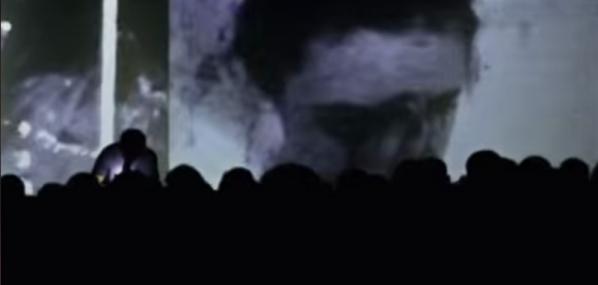
Early in his presentation, delivered with Tedtalk panache, Tim Morton used the fact that literary theory reads gender into texts even when they do not ostensibly mention gender, as an analogy for the way OOO recognizes that objects often ‘withdraw’ from us some core aspect of their being. As Morton affirmed, the Anthropocene is itself a “subcendent” object, being ‘much less than the sum of its parts’ – its parts being of a scale and complexity which must necessarily withdraw from us in order that the concept-as-object here can be revealed. This is explicitly not to infer that the concept-as-object can be emptied of its cultural and social identity and worn with Nikes like a naval overcoat, but rather that it requires a subtle and supple mode of thinking which is capable of excavating ‘that which withdraws’. The gender comment then, was prescient – directly illustrating that the curators, Lucas van der Velden and Annette Wolfsberger undermine the moral agenda of their project by failing to consider, or dismissing, the gender dimension. It might have been a calculated risk, that by not paying attention to gender during their deliberations they might elide that concept altogether from the consideration of the festival, but I think that when a risk backfires like this, the result should be called out for what it is – misguided and arrogant. At times, it felt like rather than proposing ways in which we might retreat from rampant, destructive territorialisation of the Earth, the festival projected a future in which the masculine regime of ownership and domination as ruinous could be helpfully extended and repeated onto womanhood as well – with all the faulty binarism and barbarism that implies.
The one audience question of the day, delivered from under a spotlight and with the barely subdued fury which gave him the air of Rasputin. His question, directed at Harman and Morton, I think picked up on some of the air of hypocracy of the event, but concerned the application of OOO specifically, and its relationship to Accelerationism. As my friend put it, “OOO qua Accelerationist gateway drug”. Needless to say, the question was expertly fielded and evaporated almost without trace.
Despite the regularly fascinating philosophical and cross-disciplinary gestures being made across the discourse/music strands, then, Sonic Acts was articulate through the voices it chose to exclude.
Not that the work itself, or the conversations happening across the theoretical and art strands was insubstantial. For example the way in which electronic artist TCF’s sound work performed the ontological flattening of objects as diverse as a helicopter, a computer circuit, and a Euro-house drop reflected brilliantly on the ideas proposed by Harman, Kahn and Morton, and gave a very tangible way of understanding the new materialist connotations of all. Another highlight included the Reza Negarestani double-bill, in which his notion of the incompatibility of given systems and the resulting philosophical imperative for ‘mixed-level reconfiguration’ through analyzing as both ‘that we can perceive’, and ‘that which we know’, for example, was first purposed as philosophical libereto, and then delivered as an almost equally dizzying Skype lecture.
During the deeply cerebral and attention-demanding ‘Script…’ performance, in which the audience were all seated on the floor, someone tall in mirrored sunglasses did a Jameroqui type dance while people filmed him on their mobile phones.
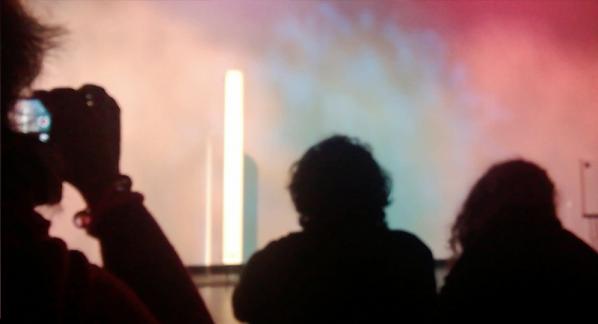
In Script for Machine Synthesis, (and previous works, such as Chimerisation) Florian Hecker has found in Negarestani’s philosophy a fantastic foil for his ‘dramatization of auditory synthesis’. Script used the motif (and the ‘occasion’) of a melting pink ice cube to enact a simultaneous synthesis and dematerialisation, bringing audio and scent (a specially commissioned perfume by Editions De Perfumes ‘materialised into a rubber trophy presented to each audience member in a foil envelope which made me think of space rations) into play as operators in the field of deconstructing the object-as-concept.
As an audience member completely new (but predisposed) to Negarestani’s work, following this hour-long performance with a lecture via Skype in which he laid out a the chiasmic twisting across neurological-phenomenological and mathematical-physical poles of experience and knowledge, led to a dizzying sense of having been teleported and improperly put back together.
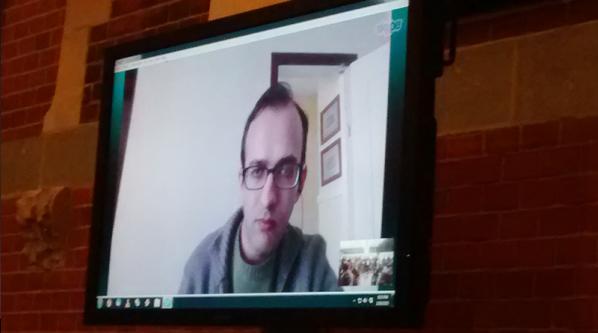
But, despite of these admirable folds in the art/thought continuum, it was impossible to shift the unnerving sense of hypocracy and lack of critical rigour at play in Sonic Acts programming. To return to the central unspoken chimera: The Anthropocene is gendered. In its simple form, it refers to a catastrophic situation resulting from the actions of a patriarchal Western society, and the effects of masculine dominance and aggression on a global scale. This was this subject in withdrawal which dominated my experience – meaning that a curatorial oversight not to include women, presumably in order to include more ‘famous’ names from these male-dominated spheres, was allowed to resonate and mutate into an experience of pervasive, almost hedonistic, misogyny I experienced during the Vessel performance.
The notoriously affluent European festival circuit benefits from a dense network of national and EU funding schemes, coupled with the neoliberal ease of intra-continental transport, cheap flights etc., and leverages this in an arms-race of fees for a mostly-male mostly-white cohort of mostly-electronic music artists. This context, plus that of the ‘lavishly illustrated’ book of essays which sets the scene for this year’s Sonic Acts, and the mode of staging in which the expert-community of the audience was silenced from contributing, in favour of a series of pronouncements from master-rhetoriticians, seems to me in direct opposition to the kind of ‘challenge to the status quo’ and subsquent reversal of the Earth’s fortunes which was frequently advocated for. The blurb for The Geologic Imagination does in retrospect seem to revel in the kind an uncritical adoption of concept Weinstein critiques, making of ecological disaster mere concept for further consumption:
“This new publication by Sonic Acts is inspired by geosciences and zooms in on planet Earth. Fundamental to The Geologic Imagination is the idea that we live in a new geological epoch, the Anthropocene. (!) Human activity has irreversibly changed the composition of the atmosphere, the oceans, and even the Earth’s crust. (!) Humanity has become a geological force. (Huzzah!)” [Exclamations mine.]
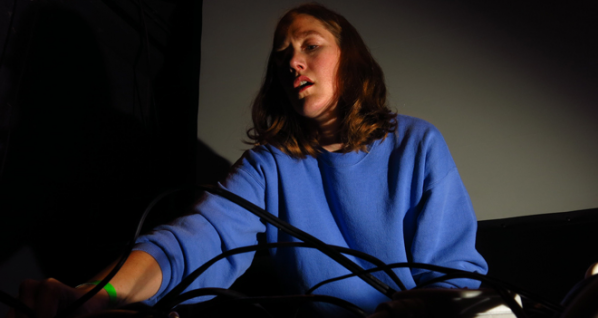
Finally, Karen Gwyer’s techno set – devoid from any descernable link with the festival themes, and so in a way also silenced somehow. But nonetheless, experienced like finally being able to breathe. The bass subdued among a mesh of pulsating synth and crystalline threads. Tim Morton’s frenetic big-box-little-box dance moves notable in the throng, somehow saying something indiscernible but very real, about the opportunities missed by this most-preeminent of European festivals. As Gwyer herself notes, in an interview not at all about the Anthropocene: “those forces have testicles.”
[imgs Jon Davies]